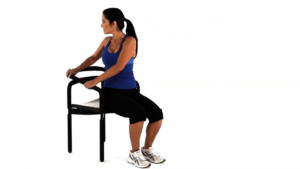
For a lot of us, 100 million American office workers, our working environment involves sitting at a desk for 8-10 hours a day. Unfortunately, these prolonged bouts of sitting are proving to be devastating to our health and wellness.
While health care costs continue to soar due to the cost of chronic disease management, we know that “sitting disease” leads to metabolic syndrome and diabetes. And we also know, based on numerous scientific research studies, that sitting disease leads to an increased risk of cancer, and metabolic dysregulation that can lead to insulin resistance, diabetes, and cardiovascular disease.
In addition to instigating the disease sequence with metabolic problems, there are the musculoskeletal issues that result from too much sitting, which can lead to the development of musculoskeletal disorders, especially in the legs, wrists, neck, knees and mid and lower back. Sitting for too long will affect your abdominal and back muscles, particularly your erector spinae muscles that run parallel to the spine. These muscles are essential for stabilizing your back, and their deterioration can lead to permanent damage to your spinal structures and cause reoccurring back pain.
The challenges continue down the waist too, as disuse causes atrophy in the hip flexors and the gluteus, which govern your range of motion and give you the power to push off from your seat. Atrophy in these muscle groups can result in weak, inflexible hips and a shorter strides and can make standing and sitting very difficult as we age if we don’t properly exercise these muscles. Weak glute muscles can also lead to hip bursitis, in which your hip bursa—fluid sacs that act as a lubricant between tissues in your hips—become painfully swollen. All of this deterioration happens every day to unsuspecting office workers glued to their chairs.
Sitting for extended periods puts you at risk for bad posture, poor circulation, joint and spine degeneration, and weight gain.
While a trip to the gym or a run before heading to the office is helpful, it’s proving ineffective in undoing the harm of sitting for prolonged periods of time.
How can you avoid the dreaded effects of the insidious office sit-in? Here are a few strategies to help incorporate more activity during the work day:
- Reimagine Your Desk Environment. Aim for a 50:50 sit-stand ratio. This can be achieved with any budget.
- A large Physio ball can act as a chair, which requires use of the abdominal muscles and good posture to keep you balanced as you sit.
- A standing desk is another option. You can accomplish this by placing a chair on top of your desk, or something more sophisticated like a Vivo standing desk
- Or a desk bicycle to keep your body moving even while you’re just sitting that can be as simple as something that fits under your desk or something as elaborate as replacing your desk with a bike and a collapsible desk
- And if your budget allows, there are treadmill desks too.
- Stretch. Stretching at your desk and is another great way to reduce your risk for pain.
- Stretch 1 – Office Chair Hip Stretch

This stretch will reduce lower back and sciatic pain. It will also increase the flexibility of your legs and hips in the process.
* Sit at your desk chair with your feet flat on the ground. Remember to sit up straight.
* Take your right foot and rest it on your left knee.
* Lift the upper body and sit up as tall as possible. Lightly hinge your hips forward.
* Hold for several breaths, switch sides and repeat up to 5 times.
- Stretch 2 – Thoracic Rotation Stretch
 When you sit with poor posture for long periods, your upper back becomes tight and stiff. This places more pressure on your lower back, but this stretch will alleviate the pain.
When you sit with poor posture for long periods, your upper back becomes tight and stiff. This places more pressure on your lower back, but this stretch will alleviate the pain.
* Sit in your desk chair with your feet flat on the ground.
* Find a neutral position for your pelvis by placing your hands on your hips and rocking forward and backward until your sitting muscles are again even on your chair.
* Place both arms on the left arm of your chair, or cross your arms across your chest with your hands near your shoulders.
* Slowly twist to your left. Hold for a few breaths. Switch to your right and repeat. Repeat both sides 4 times.
- Stretch 3 – Chest Stretch
 Our posture at our desk usually involves hunching over a computer which can cause your chest muscles to shorten and cause tightness in pectoral muscles and shoulders. To counteract the hunched position you want to open up your chest, shoulders and upper back to counterbalance the rounding forward effect with an opposing extension.
Our posture at our desk usually involves hunching over a computer which can cause your chest muscles to shorten and cause tightness in pectoral muscles and shoulders. To counteract the hunched position you want to open up your chest, shoulders and upper back to counterbalance the rounding forward effect with an opposing extension.
* Grasp hands behind your back and move them out behind you as far as possible.
* Try this seated at first, and for a deeper stretch, try grasping hands behind your back as your head slowly lowers towards your toes. Hold for 10 count and repeat 3 to 4 times.
- Stretch 4 – SCM and Lateral Neck Stretch
The Sternocleidomastoid is the large, rope like muscle at the front of each side of the neck. This muscle becomes tight with the forward cell phone, computer head position we too often find ourselves in.
* To stretch the SCM start by looking over your right shoulder (or left shoulder) then tilt your head back at a 45 degree angle until you feel the stretch. Hold for 10 count and repeat 3 to
 4 times.
4 times.
* For additional neck stretches to hit all the muscles in the neck, take your head over to one side and apply further pressure by using your hand to guide your head down. By bringing your head down to the left (or right) at 45 degree angle in front, you can work your trapezius muscles too. Hold for 10 count and repeat 3 to 4 times.
- Take Breaks. Sometimes we get so lost in our work that we don’t even know that hours have passed since we’ve gotten up and moved our bodies around. Set a timer and get up and move every 30-60 minutes. Walk the hallway, do some pushups or squats, stretches, or just stand up, but give your body a break from sitting.
- Ergonomics. The study of people at work is intended to maximize productivity by minimizing operator fatigue and discomfort. These are a few adjustments you can make to reduce fatigue and discomfort.
* Sit up tall in your office chair. Make sure your hips are as far back as possible.
* Adjust the chair’s height to allow your feet to sit flat on the floor. You want to be sure your thighs are parallel to the floor.
* Sit close to your keyboard. Also, adjust the height of the keyboard to ensure your shoulders are relaxed as you type.
* Keep often-used items, like your smartphone, close. Always stand up to reach for an object that is too far to reach while sitting.
- Ditch the Drugs. While NSAIDs (Non Steroidal Anti Inflammatory Drugs, e.g. Advil, Motrin, Ibprofin, etc.) may help relieve pain, they do not resolve the root cause of the pain instead they wipe out the healthy microorganisms (microbiome) that help your body stay healthy and leave your body ill equipped to reduce inflammation on it’s own. Most pharmaceutical drugs are a chemical reproduction of medicinal plants that exist in nature anyway. For a natural pain reliever we keep Curaphen on hand, as curcumin and tumeric which are natural anti-inflammatories and pain relievers without harming the gut flora like NSAID’s. And for natural, kid friendly pain relievers we use a liquid curcumin and hide it in a favorite beverage.
- Clean Up Your Diet. Aide your body in reducing inflammation by reducing the amount of pro-inflammatory foods in your diet. The most common inflammatory foods are white refined flours and sugars, but also include seed and vegetable oils, soy, dairy, gluten, grains, corn, and GMO’s (genetically modified organisms). When the body is inflamed via injury, poor dietary choices, chemical exposures or other stressors, it is important to support the body with the nutrients it needs to heal throughout. A whole, food diet rich in organic, seasonal, local produce and pasture raised proteins are an important step in healing your body.
- Visit A Chiropractor. Chiropractic is a great solution for office workers. The simple act of sitting is can be harmful to the musculoskeletal system if done for long periods of time. The human body was not designed to sit hunched over a desk, smartphone, or any other device for 8-10 hours a day. This ‘office’ posture places stress on the spine that can lead to misalignment, postural and spinal problems that can interfere with nerve function with excessive pressure placed on the nerves. It is this pressure or interference that causes pain and other symptoms that drive patients to seek relief.
The most common ailments that arise from poor posture include:
* Headache
* Sinus pressure
* Neck pain or neck ache
* Tingling in the arm, fingers or leg
* Frozen shoulder/loss of function in the shoulder
* Tightness in trapezius area
* Dizziness
* Fatigue
Chiropractic care can ease or eliminate symptoms by putting the body back into proper alignment and balance. Through the reeducation of muscles with therapeutic exercises, myofacial release, manual manipulation, adaptive therapies, rehabilitation, proper nutrition, and postural improvements, chiropractic treats the cause of pain, not just the symptoms by fixing the problem that causes pain.
In my practice I like to ensure my patients have the tools they need to help themselves when they’re not in my office too. I prescribe specific exercises to strengthen the back, neck and abdominal muscles so my patients learn to help themselves and prevent future injury. Stretching exercises, massage, heat/ice therapy and rest are all commonly incorporated into each patient’s treatment plan to ensure a limber, flexible, balanced, strong, and aligned body.
Just like poorly aligned tires cause excessive wear and don’t last as long or work as well as properly aligned tires, a poorly aligned spine won’t function at its peak performance level, which can affect every aspect of your life.
Reference:
